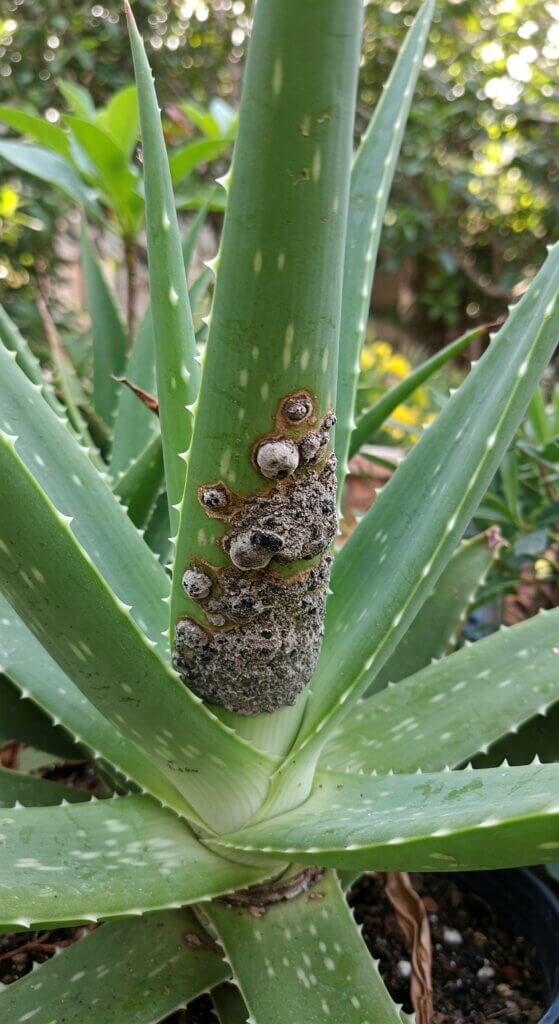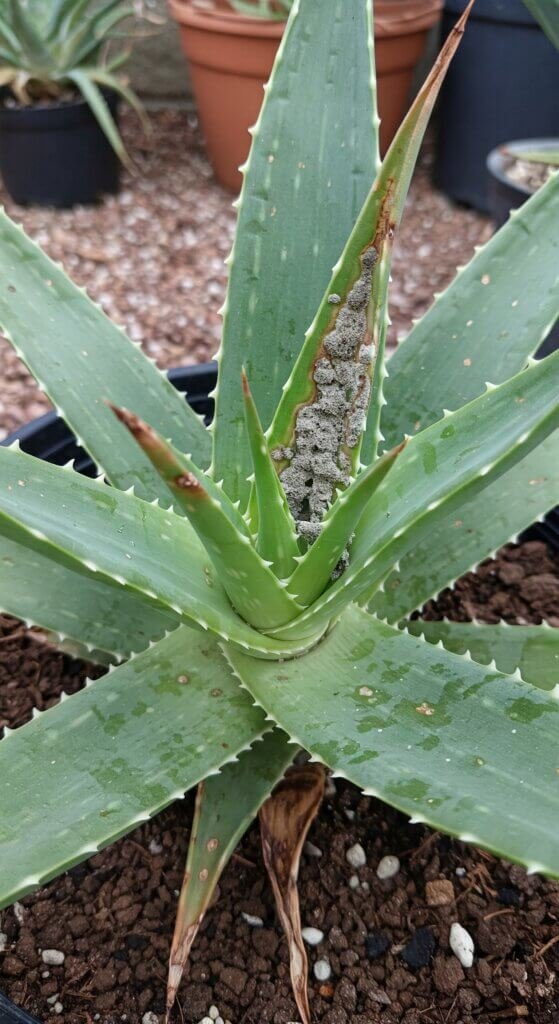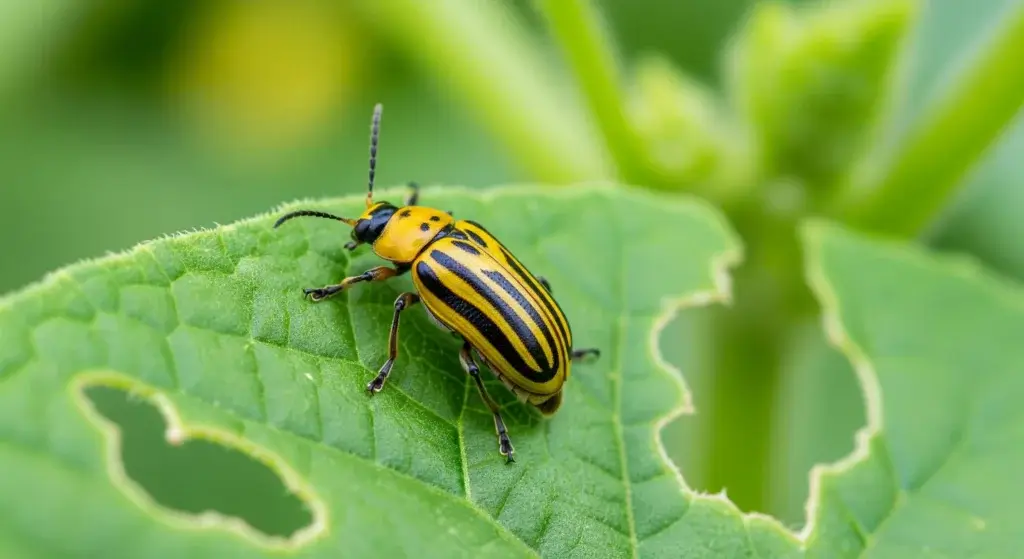
Aloe vera’s the cool, low-drama plant BFF—until too much water crashes the party.
Then boom: fungal drama.
This quick guide helps you spot the gunk, clean it up, and keep your aloe glowing like it just left a plant spa.
Fewer fungal vibes, more fresh-faced green goddess energy.
Understanding Fungal Infections in Aloe Vera
Alright, let’s talk about the not-so-glam side of aloe vera—fungal infections.
Even though this plant is basically the Beyoncé of the succulent world (low-maintenance, always glowing), it’s not immune to some gross gatecrashers.
Let’s break down the usual suspects:
Aloe rust
This one’s sneaky. It starts as tiny yellow spots on the leaves—nothing major at first.
But give it time (and some moist, chilly air), and those cute freckles turn into full-blown brown blotches.
Think of it like aloe’s version of a bad breakout from humidity and cold weather.
It doesn’t usually kill the plant, but it sure messes with its Insta-worthy look.
Black spot disease
This one’s got drama.
You’ll notice black moldy spots or blotches popping up like your aloe’s been out partying too hard and forgot skincare.
These spots mess with photosynthesis (aka aloe’s energy-making superpower), leading to faded, limp leaves and overall sad plant vibes.
Root rot
This is the silent killer.
Overwater your aloe and its roots start to drown—literally. Instead of firm, white roots, you’ll find brown, mushy noodles that smell like plant doom.
The leaves get soft and squishy, and before you know it, your aloe is melting like the Wicked Witch of the West.

Treating Fungal Infections in Aloe Vera
Alright, time to suit up and help your aloe bounce back from that fungal funk.
Think of this like a rescue mission for your plant’s skincare routine—some trimming, detoxing, and a touch of spa science.
Here’s how to fix those fungal fails and bring your aloe back to its glowy, green self:
1. Remove affected leaves
If your aloe’s got spots or mushy leaves, don’t panic—just grab some sharp scissors (sterilized, please!) and snip off the damaged parts.
Think of it like cutting split ends—you’re helping your plant ditch the dead weight.
2. Adjust watering practices
Let’s be honest: most aloe problems start with overwatering. Aloe is basically a desert diva. It doesn’t get soggy.
- Water only when the soil is completely dry: Stick a finger in the dirt—if it feels damp, back off. Aloe’s not thirsty.
- Drainage is non-negotiable: Use pots with holes (no exceptions) and cactus-friendly, well-draining soil. Wet feet = rotten roots.
3. Apply natural fungicides
Time to mix up some DIY magic.
No need for harsh chemicals—your kitchen has what you need.
- Baking soda spray: Mix 1 tsp baking soda + 1 quart of water. Spray every 2 weeks. It’s like exfoliating away the gunk without stripping the plant’s vibe.
- Aloe-neem blend: Combine aloe vera gel (yes, from the plant), a few drops of neem oil, and some water. Add lavender or tea tree oil if you’re feeling fancy.
4. Improve air circulation
Fungus loves a humid, stuffy room. Your aloe? Not so much.
- Space your plants out: If they’re packed tighter than a concert crowd, it’s time for some social distancing.
- Got indoor plants? Use a fan or crack a window. Good air = less mold = happy aloe.
The Science Behind Aloe Vera’s Antifungal Properties
Alright, let’s nerd out (in the fun way) about why aloe vera isn’t just a pretty face—it’s also got some serious fungal-fighting skills baked right into its juicy green leaves.
Aloe vera gel is loaded with natural plant compounds like salicylic acid (yep, the same stuff in acne treatments) and acemannan (a fancy sugar that fungi do not vibe with).
These ingredients act like bouncers at a nightclub, keeping out the shady fungal characters—especially troublemakers like Candida albicans.
And get this: in lab tests, aloe gel has shut down fungal growth by up to 99.33%.
That’s basically a mic drop in the world of plant-based defense systems. So yeah, your aloe is out here doing its own clean sweep without needing any backup chemicals.
It’s giving botanical superhero, but make it natural.
So next time your plant throws shade at fungus, know it’s got the science to back it up.

Preventing Future Fungal Issues
If you want your aloe vera to stay fresh, fierce, and fungus-free, think of prevention like setting boundaries—it’s all about good habits, a little space, and not letting things get too damp or clingy.
Monitor humidity levels
Fungi love humidity the way gremlins love midnight snacks.
Keep your indoor humidity under 50%, or you’re basically inviting spores to a house party.
Use a hygrometer (aka a humidity snitch) to keep tabs, and if things get too steamy, crack a window or run a small fan.
Your aloe likes a chill, dry vibe—not a rainforest rave.
Avoid overcrowding
Aloe vera doesn’t want to cuddle with its neighbors.
If your plant shelf looks like a packed subway train at rush hour, it’s time to space things out.
Good air flow = less fungal drama.
Think of it like social distancing, but for leaves.
Regularly inspect plants
Channel your inner plant detective once a week.
Look for any suspicious spots, weird colors, or general “ugh” vibes.
Catching fungal issues early is like stopping a bad haircut before it gets mullet-level tragic.
If something looks off, isolate it fast and treat it before the rest of your plant farm gets involved.
Use sterilized tools
Those cute little pruning scissors? Total germ carriers if you’re not careful.
Always wipe down tools with alcohol or soapy water before and after you use them.
It’s basically hand sanitizer for your garden gear—because dirty tools can spread fungal funk faster than spoilers after a season finale.
Quick Reference: Aloe Vera Fungus Treatment Checklist
| Task | Description |
| Prune Infected Leaves |
Remove and dispose of diseased foliage.
|
| Adjust Watering |
Water only when soil is dry; ensure proper drainage.
|
| Apply Natural Fungicides |
Use baking soda or aloe-based sprays bi-weekly.
|
| Enhance Air Circulation |
Space plants adequately; use fans if necessary.
|
| Monitor Humidity |
Keep indoor humidity levels below 50%.
|
| Inspect Regularly |
Check for early signs of infection and act promptly.
|
| Sterilize Tools |
Clean tools before and after use to prevent contamination.
|

Conclusion
Let’s be honest—keeping your aloe vera thriving isn’t exactly brain surgery, but it does need some smart care and a bit of plant-parent intuition.
Spot fungal issues early, skip the overwatering (your aloe doesn’t need a spa day every day), and let it breathe like the low-key diva it is.
Stay one step ahead: watch for weird spots, cut out the drama (literally), and keep humidity in check.
Give your plant a little space, a little sun, and the occasional check-in, and it’ll keep serving those fresh, glowy, gel-filled vibes.
At the end of the day? Be the friend your aloe deserves.
Show it some love, don’t smother it, and you’ll have a chill, healing green buddy that asks for almost nothing but gives major glow-up energy.



